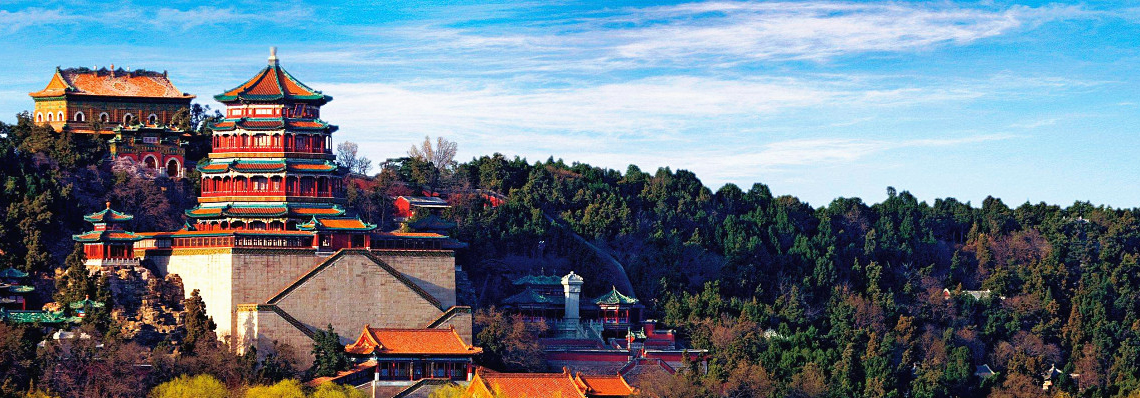
Day 1
BeijingInternational flight on your own arrangement. we will meet you at the airport, then transfer you to the hotel and check you in. Feel free at leisure for the rest of the day
Day 2
Beijing-
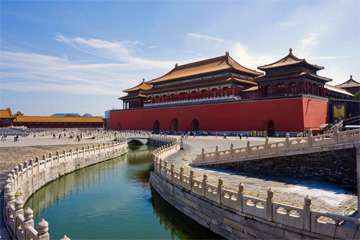
- The Tian'anmen Square
Tiananmen Square: Located at the centre of Beijing, Tiananmen, or the Gate of Heavenly Peace, is the largest city public square in the world. It was originally built in 1651 and in the 1950s it was enlarged to its current size, four times the original. It has great cultural significance as it was the site of a number of important events in the Chinese history, including the proclamation of the People’s Republic of China on October 1, 1949. It was named ‘Tiananmen Square’ because it is situated in front of the south gate of the Forbidden City - Tiananmen.
The Forbidden City: Located at the city center and called Gu Gong in Chinese, it was the imperial palace for twenty-four emperors during the Ming and Qing dynasties. It took 14 years to build during the reign of Emperor Chengzu in the Ming Dynasty (1368-1644). Ancient Chinese Astronomers believed that the Purple Star (Polaris) was in the center of heaven and the Heavenly Emperor lived in the Purple Palace.
The Temple of Heaven: Temple of Heaven, or Tiantan, is located in the southern part of Beijing, and has been one of the most sacred places for the whole country for more than five centuries. The complex was visited by the Emperors of the Ming and Qing dynasties for annual ceremonies of prayer to heaven, and is the largest one in Beijing among several royal altars to Heaven, Earth, Sun, Moon and other deities or symbolic forces of Nature.
Day 3
Beijing-
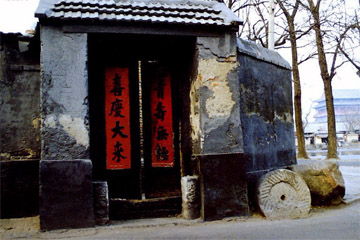
- The Ming Tomb
The Mutianyu Great Wall : Lies in Huairou County, Mutianyu Section is 73 kilometers away from Beijing City. Commanding the strategic importance, Mutianyu Section is called as the Majestic Pass on Precipitous Mountains. It is one of the best-preserved parts of the Great Wall.
The Ming Tomb : The only underground tomb of the thirteen tombs of the emperors in the Ming Dynasty. Otherwise known as the “13 Tombs”, this is the burial site of 13 out of 17 emperors of the Ming Dynasty. However, the only one you can get a good look at is the tomb of Emperor Wanli, who reigned from 1537 to 1620. This tomb was unearthed in 1956. There are two others that have been uncovered, but the rest remain illusive.
Hutong: It is said that the real culture of Beijing is the culture of the Hutong and Courtyards. That is so true. Hutong is a Mongolian word meaning water well. At nine meters wide, it is the term given to a lane or small street that originated during the Yuan Dynasty (1271–1368). These hutongs, or alleyways, are formed by lines of traditional courtyard residences. Many neighborhoods were thus formed, and the word hutong now refers to these neighbourhoods of alleyways. They have become representatives of local culture, thus it is the first choice for people who would like to learn about the local history and culture.
Day 4
Beijing-
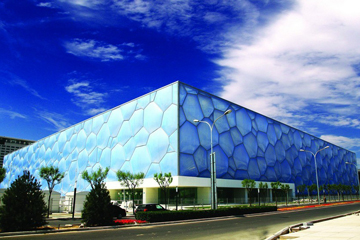
- Water Cube Aquatic Centre
Morning breakfast at the hotel, then we will be visiting The Summer Palace-a former imperial summer resort. after that, we will head to take a photo stop at the 200 Olympic Site to see the Bird's Nest National Stadium and Water Cube Aquatic Centre. Evening take the overnight soft sleeper train to Xi'an.
Summer Palace: Situated in the Haidian District northwest of Beijing City, the Summer Palace is 15 kilometers from central Beijing. Being the largest and most well-preserved royal park in China, it has greatly influenced Chinese horticulture and landscape with its famous natural views and cultural interests. It has long since been recognized as 'The Museum of Royal Gardens'.
Bird's Nest National Stadium: The National Stadium, affectionately known as Bird's Nest due to its nest-like appearance, is situated in the Olympic Green Village, in the northern Chaoyang District of Beijing. It was designed as the main stadium of 2008 Beijing Olympic Games. The Olympic events of track and field, football, javelin, hammer-throw and discus were held there.
Water Cube Aquatic Centre: Located on the west side of Landscape Avenue in the Olympic Green and to the west of Beijing National Stadium (Bird's Nest), the National Aquatics Center houses the official 2008 Olympics swimming facility. It measures 177 meters long, 177meters wide, and 30 meters high and covers an area of 62,950 square-meters. It has four floors: one at street level, two above, and one below ground.
Day 5
Xi'an-
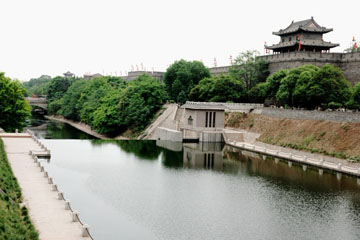
- The Ancient City Wall
Morning arrive at Xi'an,you will be transferred to your hotel. This afternoon stroll on the original City Wall, Which you have opportunity to cycle on this ancient wall, and then explore the Old Muslim Quarter and Old Mosque.Tonight enjoy a local specialty-dumpling dinner with the famous Tang Dynasty culture show.
The Ancient City Wall: This is the most complete city wall that has survived in China as well being one of the largest ancient military defensive systems in the world. It was enlarged in Ming Dynasty (1368-1644) from the city wall initially built in Tang Dynasty (618 -907). Now it is 12 meters tall, 12-14 meters wide covering 14 kilometers in length with a deep moat surrounding it. The City Wall has corner towers, ramparts, sentry towers, gate towers, battlements and a number of city defensive fortifications with very strong defense capability. You can walk, even cycle on the wall. Its south gate is the largest with a suspension bridge. Most of the tourists choose the south gate for sightseeing.
Grand Mosque (and Old Muslim Quarter): The Grand Mosque is a Chinese traditional Alhambresque architecture with a long history and grand scale, and is a great combination of Islamic and Chinese culture. It was recorded that it was established in the first year of the Tian Bao reign by the Tang Dynasty Emperor Li Lung Ji (685AD-762AD). After renovations and expansions on several occasions in the Song, Yuan and especially the Ming and Qing Dynasties, it gradually took on the current appearance. The whole mosque has more than 12,000 square meters, the floor space more than 4,000 square meters. The construction is mostly in the Ming Dynasty style. The Mosque therefore has much Chinese traditional touch in both its design and artistic outlook. Besides the style peculiar to Islamic mosques, this Mosque also holds characteristics of Chinese pavilions with painted beams and engraved ridgepoles. The Grand Mosque and the Muslim Quarter are now an important cultural preservation of Shanxi Province and a national-level historical/cultural preservation site.
The Tang Dynasty show: This is the show that presents the palace dances and songs from the Tang Dynasty (618AD-907AD) when Xian was the capital of China.
Day 6
Xi'an-
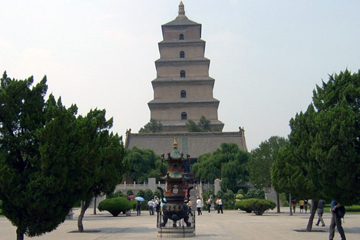
- The Wild Goose Pagoda
After breakfast visit the historical significance of the amazing The Terra-cotta Warriors and Horses -where7000 individually crafted clay soldiers stand on guard.Then continue to the Bid Wild Goose Pagoda built to house Buddhist scriptures collected by a Chinese Monk, where you can see variety of buddha statues before flying to Chengdu.
The Terra-cotta Warriors and Horses: This is one of the greatest archaeological findings of the 20th century - the army of terra-cotta warriors and the bronze chariots entombed in vast underground vaults at emperor Qin Shi Huang's tomb from two thousand years ago. It is a sight not to be missed by any visitor to China. Emperor Qin Shi Huang ascended to the throne of Qin at the age of 13 in 246 BC. Under him, Qin conquered the other six warring states and became the first true emperor, or Shi Huang, of China.
Big Wild Goose Pagoda: The Big Goose Pagoda is where the renowned Buddhist Master Xuanzang (Monk Tripitaka) stored his classics brought back all the way from India. The pagoda is one of the oldest structures in China. Originally it consisted of a brick structure of five storeys and was about 60 meters high. It was first built in 589AD during the Sui Dynasty. Between 701AD and 704AD during the reign of the Empress Wu Zetian five more storeys were added to the pagoda making it ten in all.
Day 7
Chengdu-
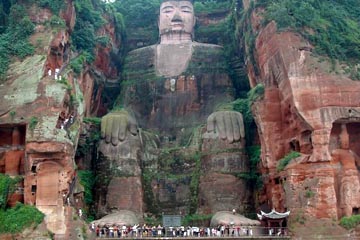
- Leshan Buddha Sculpture
After breakfast take a scenic drive to the world's largest Buddha Statue(71m high) at Leshan County, walk down to the foot of the Buddha and hope on a river cruise to appreciate its fill stature and splendor from the river. Tonight sample a local specialty dinner.
Leshan Buddha Sculpture: The Giant Buddha (Dafo in Chinese) of Leshan is the tallest stone Buddha statue in the world, carved out of a cliff face by an 8th-century monk in southern Szechuan province. The Giant Buddha overlooks the confluence of the Minjiang, Dadu and Qingyi rivers and faces the sacred Mount Emei (with which it shares its World Heritage status). Construction on the Giant Buddha began in 713 AD. It was the idea of a Chinese monk named Haitong, who hoped that the Buddha would calm the turbulent waters that plagued the shipping vessels traveling down the river. His plans were not just supernatural, as it turned out. What had happened was that the enormous amount of rubble carved away from the cliff would be deposited in the river, actually altering the currents and calming the waters.
Day 8
Chengdu-

- Giant Panda Breeding and Research Centre
After breakfast visit the fascinating Giant Panda Breeding and Research Centre to learn morn about these amazing endangered animals and the programs that are being implemented to protect them. Later explore bustling teahouses and take a stroll in the lively People's Park before being flying to Lijiang.
Panda Reserve: This is the Giant Panda Breeding and Research Centre - Zoos, scientific research centers, breeding centers, or semi-protected areas work together to maintain a self-sustaining population of a given species. This population may serve as a hedge against extinction of the species, as well as a reservoir for improved understanding of its natural history. The Chengdu Panda Base is an example of a scientific institute engaged in research towards conservation. The goal is not only to provide technical support for scientific research on wild pandas, but also to increase the wild population through improved management and, ultimately reintroduction of individuals into areas from which the populations have declined. Research at the Chengdu Panda Base focuses on the advancement of wildlife conservation in China.
Day 9
Lijiang-
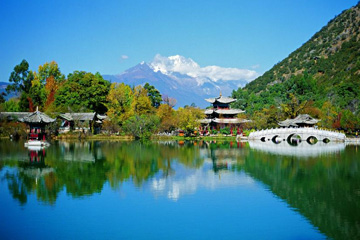
- Black Dragon Pool Park
In the Morning we will visit the Black Dragon Pool Park to catch the beautiful views of the Jade Dragon Mountain, where from a distance this mountain looks like a dragon flying from within the clouds,and then explore the World Heritage Site of Lijiang Ancient Town and wander through the ornately-carved wooden buildings,teahouses and cobbled street interspersed with mini canals and stream.Enjoy a dinner at the courtyard local family.
Black Dragon Pool Park: Somewhat idiosyncratically known as Black Dragon Pool, the Jade Spring Park to the north of Lijiang derives its name from the waters which sparkle like jade and are as clear as spring water. The entire park is green with grass and shaded by swaying willow trees. Under the Shuocui Bridge, a waterfall creates a constant roar as it cascades downstream. At the far side of the pool, there are renovated buildings used for art exhibitions, the Moon-Embracing Pavilion with its own white marble bridge across the water, and the Five-Phoenix Temple built during the Ming Dynasty.
Lijiang Ancient Town: Lijiang Old town is officially called "Dayan Town", "Dayan" literally means a "great ink slab", a graphic description of the town's location on a piece of rich flatland fed by a river and surrounded by green mountains. Dayan Town is the large Naxi settlement first built during the Southern Song Dynasty some eight centuries ago. Dayan Town is one of the few places in China with well-preserved old style folk buildings.
Day 10
Tiger Leaping Gorge-
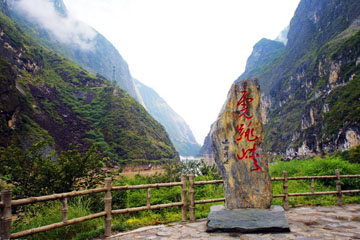
- Tiger Leaping Gorge
Enjoy a relaxing drive to the First Bend of Yangtze River before going to see the world's deepest gorge -Tiger Leaping Gorge,and then head to Shangri-la.a land of forests.grassland mountains and Tibetan culture.
First Bend of Yangtze River :First Bend of Yangtze River: Starting from the Qinghai-Tibet Plateau, the Yangtze River surges southeastward until it meets the Hengduan Mountain Range. About 44 miles outside of Lijiang the Yangtze is forced to make a sudden V-shaped bend and flow to the northeast. This extraordinary turn creates beautiful and marvelous views that startle the imagination. The whole sight is like a wonderful landscape painting that never ends. This is the First Bend of the Yangtze River, the third longest river in the world.
Tiger Leaping Gorge: The Tiger Leaping Gorge is on the Jinsha River segment of the upper reaches of the Yangtze and 105 kilometers south of Zhongdian County. It is 17 kilometers long with a drop of 213 meters. The gorge is divided into three sections: Upper, Middle and Lower Hutiao (tiger leaping). At the narrowest spot the river is only 30 meters wide. The mouth of the gorge is 1,800 meters above sea level. The river is flanked by Yulong and Haba snow mountains, with a height difference of 3,900 meters. It is one of the deepest gorges in the world.
Day 11
Shangri-la-
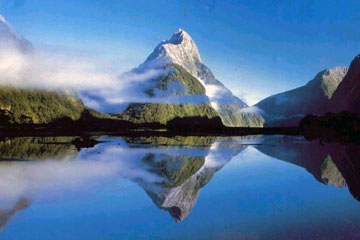
- Napa Lake
After breakfast explore the mystical prayer halls and temples of the 300 year old Songzanlin Tibetan Monastery, before taking a nature walk along the Napa Lake.Then visit the lush Tibetan villages and friendly families before going to final stop at a Tibetan Old Town and enjoy a Tibetan dinner.
Songzanlin Tibetan Monastery: Being the largest Tibetan Buddhist monastery in Yunnan, Songzanlin Monastery, also known as Guihua Monastery, is one of the most famous monasteries in the Kang region. The monastery is located near Shangri-La County, at the foot of Foping Mountain. Construction of the monastery began in 1679 and was completed two years later. The monastery seems like a group of ancient castles and is composed of two lamaseries, Zhacang and Jikang.
Napa Lake: Napa Hai ("Lake behind the forest") Nature Reserve is a state-designated wetlands area situated some 8 kilometers north of Shangri-La County (aka Zhongdian County) on the Yunnan-Guizou Plateau in northwestern Yunnan Province. Not surprisingly, this wetlands area is a true paradise for all types of birds, most especially for water fowl. In spring, the higher, drier parts of the reserve is a prairie landscape carpeted with flowers. Parts of this prairie are farmed, the main crop being highland barley.
Tibetan Old Town: a 1300-year-old Tibetan town located in Shangri-La, which it has experienced both the flames of war and prosperity of frontier trade. Dukezong Old Town's authentic Tibetan dwellings, majestic prayer halls and pagodas, winding lanes offer sanctuary to all those seeking refuge from the bustle city.
Day 12
Shangri-la-
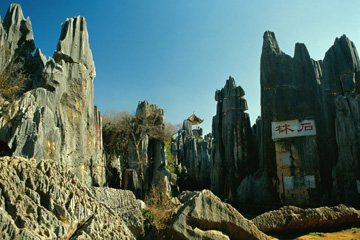
- Stone Forest
In the morning flying to Kunming, visit the natural wonder-the Stone Forest,you will be amazed by the bizarrely shaped limestone cliffs and peaks which have formed by erosion after the sea bed was thrust up 270 million year ago. Then you will be transferred to the airport and take the flight to Guilin.
Stone Forest: This fantastic natural phenomenon is located 90 km southeast of Kunming. It covers an area of 400 square kilometers (96,000 acres) and includes both large and small stone forests, as well as many other scenic spots. The various shapes of karst landscape were formed due to the millions of years of movement of the earth. The Stone Forest area is the home of the Sani people, their folk customs has become one spectacular scene. The colorful embroidery and minority dances combine with the natural sceneries will surely leave you with a deep impression. The site is truly one of the most important attractions of Yunnan. Walking through the site, visitors marvel at the natural stone masterpieces and are bewitched by the intricate formations. A local saying says that 'If you have visited Kunming without seeing the Stone Forest, you have wasted your time.'
Day 13
Guilin-
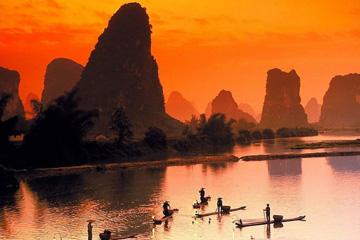
- Li River Cruises
After breakfast enjoy the spectacular Li River Cruises. The cruise ship goes past the bizarre shaped mountains,villages and water buffaloes.Disembark at the traditional country town of Yangshuo.
Li River Cruises:The Li River (Lí Jiāng, pronounced Lee Jyang) is the main river system of Guilin Prefecture, Northeast Guangxi. Originating from Kitten Mountain (Mao’er Shan), the Li River winds its way south for 437 km (272 miles). The 83-kilometer-long (52-mile-long) section between Guilin and Yangshuo is the most beautiful part.The Li River from Zhujiang Pier (Guilin city suburbs) to Yangshuo is like an artist's masterpiece. The landscape is decorated with startling hills, steep cliffs, fantastic caves and farming villages, and is lined with bamboo groves. In a Chinese poem it is written: "The river is a green silk ribbon, and the hills are jade hairpins".It is a Chinese tradition to divide the long trip into sections (just as the Three gorges along the Yangtze River) and give each peak an imaginative name. Although some take much of your imagination to see what it is like, listening to tour guide's legendary stories behind them is a delightful experience when you are appreciating the landscapes. Most are mystical fairy and love stories. The writer choose some of the peaks and places to illustrate below. (They are presented in order of location along the River.
Day 14
YangshuoSpend a free day to explore tranquilly countryside and local villages,see rice paddies and fish farms.There are many activities to day,such as cycling,bamboo boat drifting,bargain shopping and cooking class. After that, we will drive back to Guilin for rest.
Day 15
Guilin-
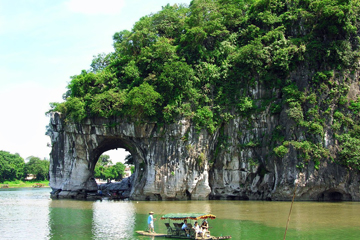
- Elephant Trunk Hill
Visit" Palace of Natural Art"Reed Flute Cave,view the beautiful vista of the Elephant Trunk Hill
Elephant Trunk Hill : is located on the western bank of Li River. The shape of the hill is just like a huge elephant drinking water from the river with its trunk, so it is called Elephant Trunk Hill.Shui Yue Cave (Water Moon Cave) is between the trunk and the legs, which is a semi-round cave penetrated by water. The inverted reflection of the cave in water plus the part above forms a full moon. This phenomenon is unique and many laudatory inscriptions were found on the wall inside the cave. Visitors can boat through the cave to the river.
Palace of Natural Art"Reed Flute Cave:Known as “the Palace of Natural Arts”, Reed Flute Cave's remarkable features impress domestic and foreign visitors alike. Situated at the foot of Guangming Hill in northeastern Guiln, Reed Flute Cave got its name from the kind of reed growing immediately outside the cave entrance, which is used to make fine flutes.It has been a tourist attraction for more than 1,000 years. Inside the cave, there are various stalagmites, stone curtains, stone flowers and stone pillars, which constitute a unique charm, making it known as a palace of natural art.This limestone cave with impressive stalactite and stalagmite formations makes the Reed Flute Cave well worthy of a visit.According to legend, it is believed that the green reed could be made into flutes to create dulcet music. The exuberant reed covered the entrance to the cave, so the people of the area used this cave for many centuries as a hideout in times of war.
Day 16
GuilinIn the morning you will be transferred to the train station and take the express train to Guangzhou. Arrive at Guangzhou, continue transferred to a short train to Hong Kong.
| Travel in party of |
Superior Class ★★★★★ |
Deluxe Class ★★★★ |
Tourist Class ★★★ |
| 2-5 persons | N | $ | $ |
| 6-9 persons | N | $ | $ |
| 10 persons & above | N | $ | $ |
| Single room Supplement | N | $ | $ |
Service included:
√ Meals as listed in the itinerary, B=breakfast; L=lunch ;
√ Personal Guide & Driver + Private car / van for Private Transfers & sightseeing
√ Hotels with breakfast(twin share bases) as listed in the itinerary .
√ Domestic flights or trains as listed in the itinerar
√ Airport Taxes: US$30for domestic,
√ Service Charge & Government Taxes .
√ Luggage Transfers between airports and hotels
√ Goverment letter for visa support
Service excluded:
* Personal expenses, tips to the guide and driver.
Note, the price for 6-10 pax included Lunches and Dinners1 Entrance fees/
* Meals as listed in the itinerary, B=breakfast; L=lunch ;
* Personal Guide & Driver + Private car / van for Private Transfers & sightseeing
* Hotels with breakfast(twin share bases) as listed in the itinerary .
* Domestic flights or trains as listed in the itinerar
* Airport Taxes: US$30for domestic,
* Service Charge & Government Taxes .
* Luggage Transfers between airports and hotels
* Goverment letter for visa support

